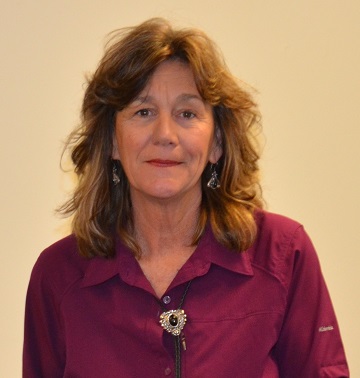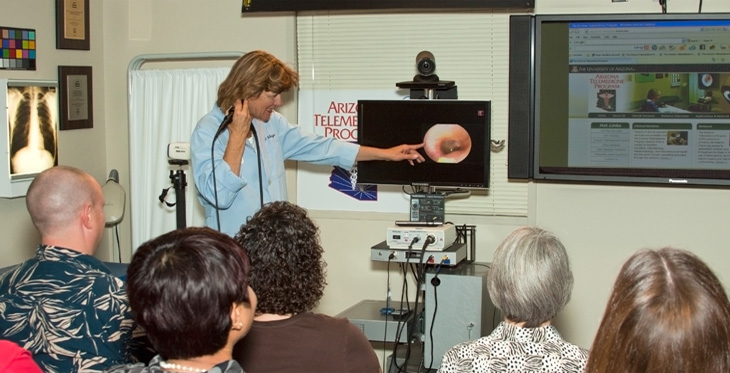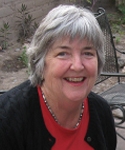Like most Americans, Janet Major is thankful today for her family, friends, and all the good things in her life. One of those good things is working at a job she loves.
Janet is associate director for facilities and distance learning outreach for the Arizona Telemedicine Program (ATP). She’s been with ATP since 1997, when the first telemedicine site was installed at what is now called Maricopa Community Health Center in Nogales, AZ. Janet was on the team that installed it.
Over the past 18 years she has traveled throughout Arizona, helping to grow the ATP network that now links with more than 150 healthcare sites statewide. She also serves as vice chair, and chair elect, of the American Telemedicine Association’s Technology Special Interest Group, and is a board member representing telehealth with the U.S. Distance Learning Association.
“I have the best job on the planet,” she says, with Janet-like excitement.
Janet’s journey to a career in telemedicine started in Northern Arizona University’s telecommunications department during her freshman year. She had thought she wanted to be a nurse. “But one class in anatomy and physiology was all the bones and blood and guts I could handle,” she recalls.
She graduated with a bachelor’s degree in telecommunications, with a focus on theater production and direction. Her first professional job was working as stage manager for Up With People, the musical group with a mission of enhancing education and cross-cultural understanding worldwide.
Her next job was with UA Presents, working as technical director for theater and musical productions in Centennial Hall. University of Arizona Health Sciences colleges also hold their convocations there, and she got to know people with Biomedical Communications, who taped the events. When they had an opening, they called Janet and asked her if she knew anyone who might be interested.
“Well, of course – me!” she answered.
When the telemedicine program needed some temporary help, Janet went to work with them. By the end of her “temporary” assignment, ATP wanted her to stay. That was 18 years ago.
From theater classes at NAU to being named an associate director for ATP may seem an unlikely progression. But as Janet points out, Ronald S. Weinstein, MD, co-founder and director of ATP, often refers to telemedicine as “improvisational theater,” where one learns to expect the unexpected.
 “To have the telemedicine job I have now is a blessing,” she says. “The things we do now are more challenging, and more necessary – things like emergency response drills to prepare the workforce that will have to deal with those things.
“To have the telemedicine job I have now is a blessing,” she says. “The things we do now are more challenging, and more necessary – things like emergency response drills to prepare the workforce that will have to deal with those things.
“It’s a good relationship,” she adds. “I need the doctors to do the blood and guts part and they need me to teach them how to talk on camera.”
Of all the interesting – even amazing – experiences Janet’s enjoyed through her work with telemedicine, two stand out.
One involved working with “a wonderful group of Girl Scouts” at opposite ends of Arizona – in Tuba City on the Navajo Reservation, and in Nogales, AZ, at Maricopa Community Health Center, ATP’s first “live” telemedicine site. Her work with the Girl Scouts was part of a diabetes prevention project called the Arizona Diabetes Virtual Center of Excellence – ADVICE – funded by the Arizona Department of Health Services.
Scouts from Tucson taught students in both communities about diabetes risk and prevention, how to use glucometers, how to talk about diabetes at home with their families. And the students passed their knowledge on to their classmates, translating terminology in English into the Navajo language and Spanish. They also produced plays – with Janet providing props and a script, as well as technical direction – to get their prevention message to the rest of their communities.
“It was absolutely an honor to be a part of it,” Janet says.
Her other most memorable experience occurred on Sept. 11, 2001. She and ATP colleagues were working to establish telemedicine services in Panama, as part of ATP's international outreach programs.
“We walked into the Social Security Hospital in between the first plane and the second plane hitting. Everybody knew we were American. When we arrived people grabbed us and took us to the closest TV where we watched the second plane hit. It was the world standing still. We stuck to our plan of buying computers and software, and everywhere I went everybody hugged me, everybody was crying. It was the longest day of my life. That night I called home and said, ‘I’m OK. How was your day?’”
Janet’s excitement about the future of telemedicine is contagious.
“I think one of the most exciting things we have right now, is to be able to provide services by having an iPad in a patient’s home, creating a two-way video between patient and provider. We can do that in a HIPAA-compliant way.
“It’s a whole new world from when I started 20 years ago” she says. “I can’t wait to see where it goes next.”

